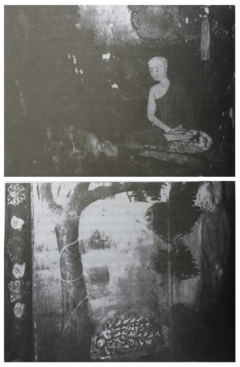Dhutanga
Dhutanga (Pali dhutaṅga "renunciation",[1] known in Thai as "Thudong"; Sinhala: ධුතාඞ්ග) is a group of thirteen austerities or ascetic practices most commonly observed by the practitioners of the Thai Forest Tradition of Theravada Buddhism. While the Buddha did not require these practices, they were recommended for those wanting to practice greater asceticism.

| Part of a series on |
| Buddhism |
|---|
 |
|
|
|
Description
All Forest Monks will observe at least one of the dhutanga austerities. The dhutanga austerities are meant to deepen the practice of meditation and assist in living the Holy Life. Their aim is to help the practitioner to develop detachment with material things including the body.
The thirteen dhutanga practices
The Pāli Canon mentions the thirteen ascetic practices in various places.[2] In addition, the 5th-century commentary Visuddhimagga devotes a whole chapter to discussing them and lists the practices as follows:[3]
- Refuse-rag-wearer's Practice (pamsukulik'anga) — wearing robes made up from discarded or soiled cloth and not accepting and wearing ready-made robes offered by householders.
- Triple-robe-wearer's Practice (tecivarik'anga) — Having and wearing only three robes and not having additional allowable robes.
- Alms-food-eater's Practice (pindapatik'anga) — eating only food collected on pindapata or the almsround while not accepting food in the vihara or offered by invitation in a layman's house.
- House-to-house-seeker's Practice (sapadanik'anga) — not omitting any house while going for alms; not choosing only to go to rich households or those selected for some other reason as relations, etc.
- One-sessioner's practice (ekasanik'anga) — eating one meal a day and refusing other food offered before midday. (Those Gone Forth may not, unless ill, partake of food from midday until dawn the next day.)
- Bowl-food-eater's Practice (pattapindik'anga) — eating food from his bowl in which it is mixed together rather than from plates and dishes.
- Later-food-refuser's Practice (khalu-paccha-bhattik'anga) — not taking any more food after one has shown that one is satisfied, even though lay-people wish to offer more.
- Forest-dweller's Practice (Araññik'anga) — not dwelling in a town or village but living secluded, away from all kinds of distractions.
- Tree-root-dweller's Practice (rukkhamulik'anga) — living under a tree without the shelter of a roof.
- Open-air-dweller's Practice (abbhokasik'anga) — refusing a roof and a tree-root, the practice may be undertaken sheltered by a tent of robes.
- Charnel-ground-dweller's Practice (susanik'anga) — living in or nearby a charnel-field, graveyard or cremation ground (In ancient India there would have been abandoned and unburied corpses as well as some partially cremated corpses in such places.)
- Any-bed-user's Practice (yatha-santhatik'anga) — being satisfied with any dwelling allotted as a sleeping place.
- Sitter's Practice (nesajjik'anga) — living in the three postures of walking, standing and sitting and never lying down.
Early Practitioners
- Maha Kassapa Thero (the greatest among Dhutanga Practitioners)
- Sariputta Thero (the greatest among the Wise and greater among Dhutanga Practitioners)
- Khadiravaniya Revata Thero (the greatest among Forest Dwellers)
- Bakkula Thero (the greatest among Sitters)
- Moghraja Thero (the greatest among Rough Robe Wearers)
- Nalaka Thero (the beginner of Nalaka Patipada)
Notable Modern Practitioners
- Thailand - Ajahn Sao Kantasilo, Ajahn Mun Bhuridatta, Ajahn Lee, Ajahn Chah, Luang Pu Waen Sucinno, Ajahn Thate
- Sri Lanka - German Nyanavimala Thera,[4][5] American Bikkhu Kovida,[6] Matara Sri Nanarama Mahathera, Katukurunde Nanananda Thera, Danish Nyanadipa Thera,[7] English Nanavira Thera,
- Myanmar - Webu Sayadaw
Notes
- The 13 ascetic practices dhammadana.org
- Bhikkhu Khantipalo. "With Robes and Bowl: Glimpses of the Thudong Bhikkhu Life". Retrieved 2020-04-12.
- Bhikkhu Ñāṇamoli (2011). The Path of Purification: Visuddhimagga (PDF). Buddhist Publication Society. pp. 55–77.
- "Reminiscences of Venerable Ñāṇavimala Mahāthera" (PDF).
- "Pure Inspiration" (PDF).
- "A Majestic Tree of Merit" (PDF).
- "meetings-with-remarkable-monk".
References
- Source: The Path of Freedom (Vimuttimagga), Buddhist Publication Society, Kandy, Sri Lanka. ISBN 955-24-0054-6
- 13 ascetic practices of Buddhist monks
- With Robes and Bowl: Glimpses of the Thudong Bhikkhu Life
- THE PATH OF PURIFICATION (VISUDDHIMAGGA) BY BHADANTACARIYA BUDDHAGHOSA - CHAPTER II - THE ASCETIC PRACTICES (Dhutanga-niddesa)
- Ascetic practices
- Sri Lanka - German Nyanavimala Thera, American Bikkhu Kovida,Danish Nyanadipa Thera,